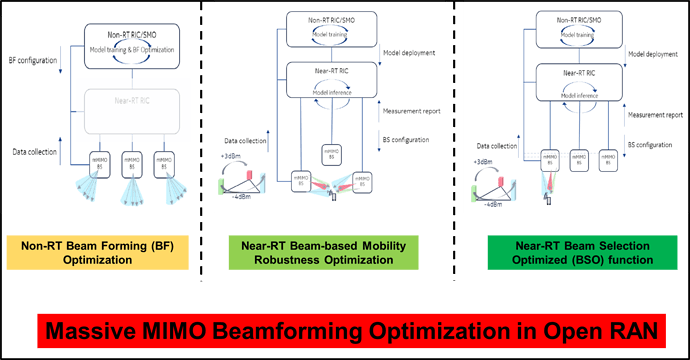-
My friend: Hi Ibrahim, I have a question for you.
- Me: Please, go ahead.
-
My friend: What is the difference between massive MIMO Beamforming Optimization in Open RAN and legacy RAN solutions?
-
Me: The massive MIMO Beamforming optimization use case in O-RAN Alliance aims at proactively and continuously improving cell and/or user coverage, capacity and mobility performance by adapting different beam configurations, so you can say that many parameters such as no. of beams, beam direction, beam horizontal and vertical widths can be changed.
So, the beam configuration won’t be static like legacy RAN solutions where once configured, it is fixed and can only be changed manually.
-
-
My friend: But how can this be achieved?
- Me: In this use case three optimization loops for mMIMO and Beamforming are proposed which are:
-
An outer non-RT loop mMIMO GoB (Grid of Beams) Beamforming Optimization inside the non-RT RIC,
-
An inner near-RT loop mMIMO Beam-based Mobility Robustness Optimization (bMRO), and
-
An inner near-RT loop mMIMO Beam Selection Optimization (BSO) and these last two loops are inside the near-RT RIC.
So, for example the non-RT RIC can host an App to collect, process, and analyze antenna array parameters, cell performance KPIs, UE mobility data, traffic density data, beam measurement data, CSI measurements, power headroom reports (PHRs), and neighboring cells’ beams/interference information.
Then the output can be optimized Beam configuration, number of beams, beam elevation, beam horizontal & vertical widths and power allocation of beams and this will be done to achieve a specific MNO strategy such as covering low-density areas with wide beams and high-density areas with narrow beams.
-
My friend: So, what about the other two loops inside the near-RT RIC?
-
Me: The near-RT RIC may host Apps to monitor UE/traffic density measurements, UE positioning information, beam-based mobility, and beam failure KPIs and select/deploy optimized mMIMO Beamforming parameters to E2 nodes.
So, optimizing inter-cell beam mobility such as beam-based Mobility Robustness Optimization and in this case the near-RT RIC might for instance configure beam individual offsets for inter-cell mobility decisions between different beams in different cells.
Also, optimizing intra-cell beam mobility such as mMIMO Beam Selection Optimization and in this case the near-RT RIC might for instance configure parameters for intra-cell beam switching decisions and this will be done to minimize the beam failure rate for a group of users (e.g., high-mobility users). And kindly note that the inner loops can run independently or together with the outer loop.
-
-
My friend: Thank you so much. You made it very clear.
- Me: You are most welcome.
LinkedIn: Ibrahim Sayed, PMP on LinkedIn: #5g #5gnr #5gtechnology | 10 comments
